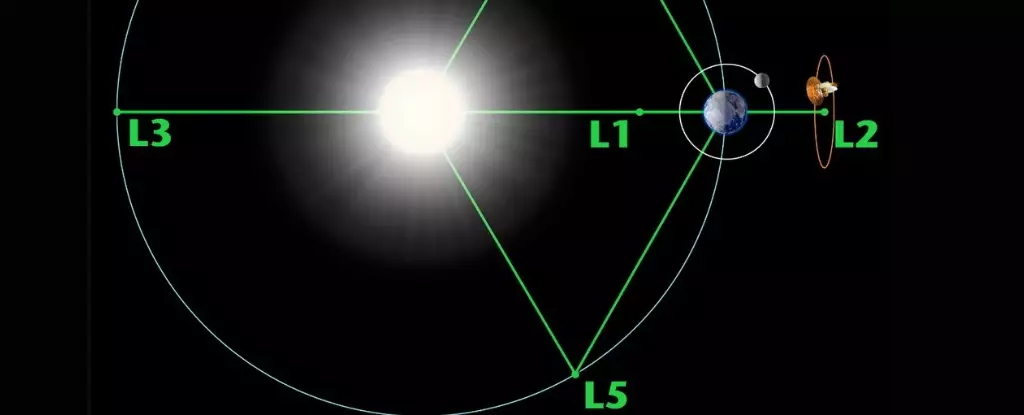A new era of space exploration has begun, with the United States and China engaging in a heated “space race” that centers around Lagrange points. These points, named after Joseph-Louis Lagrange, refer to specific locations in interplanetary space where the gravitational pull of two celestial bodies achieves a delicate balance with the centripetal force required for a smaller object to orbit steadily between them. This article will delve into the significance of Lagrange points, particularly L2, L4, and L5, as strategic battlegrounds for space research and domination.
Lagrange points hold immense value due to their stability and suitability for various space-based activities. L4 and L5, positioned 60 degrees ahead and behind Earth (plus the Moon) on its orbital path around the Sun, are particularly advantageous parking spots for satellites and telescopes. The stability of these points allows spacecraft to remain in position for extended periods without expending excessive fuel to adjust their orbits. This characteristic provides an uninterrupted view of Earth, its natural satellite, and offers an ideal vantage point for studying weather patterns. Additionally, the absence of atmospheric interference and the proximity of L1 and L2 to the Moon make these positions attractive for scientific observations.
L2, specifically, is a location of utmost importance for space exploration due to its visibility to the far side of the Moon. From the Sun’s perspective, L2 is positioned 1.5 million kilometers (932,000 miles) “behind” Earth. While it orbits the Sun at the same speed as Earth, it is approximately four times farther away than the Moon. L2 offers an unobstructed view of deep space, making it an ideal spot for sensitive telescopes such as the James Webb Space Telescope (JWST). Recognizing its potential, China has already sent the Queqiao relay satellite to L2 in the Earth-Moon system to facilitate communication with the Chang’e 4 lunar probe, the first successful landing on the far side of the Moon.
Both the United States and China are vying for control over L2 and other Lagrange points. The US, in its efforts to maintain its dominance in space research, communications, and surveillance, is planning missions like the Gateway lunar outpost, set to launch in the late 2020s, which will focus on establishing a permanent presence at L2 in the Earth-Moon system. Laura Duffy, a space systems engineer, emphasized the importance of L2, stating, “We cannot see the far side of the Moon from Earth, and China is headed there.” China, on the other hand, has made significant strides in its space program, with notable missions such as the Chang’e 5 lunar sample return and the upcoming Chang’e 6 mission to the Moon’s south pole. The Chinese space station, Tiangong, is already operational, and the country is actively working towards sending taikonauts (Chinese astronauts) to the Moon in the near future.
The US-China rivalry is not solely confined to space exploration; it encompasses economic and technological aspects as well. A recent bipartisan report from the US House of Representatives recommended “fundamentally resetting” the relationship between the two nations, proposing nearly 150 policy recommendations. The report emphasizes the critical role of funding NASA’s and the Department of Defense’s programs in countering China’s aspirations in space. It specifically suggests ensuring that the United States becomes the first country to permanently station assets at all Lagrange points to establish dominance in multilateral space governance and promote scientific discovery and innovation.
While the focus of the new space race lies between the United States and China, it is crucial to acknowledge the potential for collaboration and the involvement of other countries. Projects like the International Space Station demonstrate the ongoing collaboration between nations to advance our understanding of the Universe. Lagrange points have piqued the interest of the international community, with organizations such as the European Space Agency developing their own missions to these strategic locations. The competition and collaboration surrounding Lagrange points will undoubtedly shape the future of space exploration and push the boundaries of human knowledge.
As the race for space dominance intensifies, Lagrange points have emerged as significant battlegrounds. The stability and unique characteristics of these points make them valuable for various space-based activities, ranging from observation of Earth’s weather patterns to deep-space exploration. L2, in particular, holds immense potential due to its visibility of the far side of the Moon. While the US and China compete for control over L2 and other Lagrange points, it is essential to recognize the potential for collaboration among nations. The significance of Lagrange points in advancing our understanding of the Universe and pushing the boundaries of space exploration cannot be overstated. The battle for Lagrange points marks a new chapter in the exploration of the cosmos and promises to shape the course of astronomy and space research for years to come.


Leave a Reply